Light therapy can effectively treat your Seasonal Affective Disorder (SAD) when you use a device that delivers 10,000 lux of full-spectrum light for 30-60 minutes each morning. You'll find several options, including light boxes, desk lamps, travel lights, and wake-up lights. Morning sessions work best, with remission rates of up to 80% when timed correctly. While light therapy alone helps many people, combining it with Cognitive Behavioral Therapy (CBT) often produces better long-term results. For maximum success, you'll need consistent daily treatments throughout winter months. Understanding your specific needs and treatment options will help you make the most informed choice for managing SAD.
Understanding Light Therapy Basics
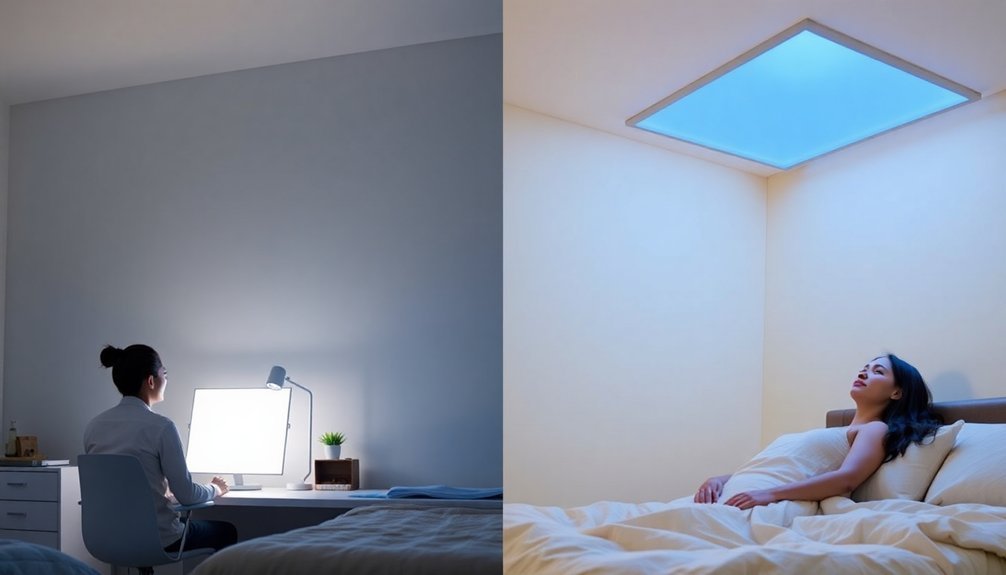
Shining a light on seasonal depression, light therapy serves as a powerful treatment by mimicking natural sunlight during darker months.
When you're exposed to this artificial sunlight, your brain responds by adjusting essential hormones that regulate your mood, sleep patterns, and appetite. Women in their reproductive years are most commonly affected by SAD and may particularly benefit from light therapy.
The science behind light therapy is straightforward: it works by affecting your body's levels of serotonin and melatonin, two key hormones that influence how you feel and sleep. By helping to correct your circadian rhythms (your internal body clock), light therapy can effectively reduce symptoms of Seasonal Affective Disorder (SAD).
You'll find that light therapy devices come in different forms, with light boxes being the most common option. These boxes use full-spectrum fluorescent light that's specifically designed to treat SAD symptoms.
For the treatment to work, you'll need to sit near a light therapy box for about 30 minutes daily, with the device producing between 2,500 to 10,000 lux of light. While dawn simulators and natural spectrum light bulbs are available alternatives, light boxes remain the most widely used and studied option for SAD treatment.
Different Types of SAD Lamps
Now that you understand the basics of light therapy, let's explore the specific types of SAD lamps available. You'll find a range of options, from portable devices for travel to larger desktop models for home use. Most effective SAD lamps deliver between 2,500 to 10,000 lux, with higher intensities allowing for shorter treatment sessions. For optimal therapeutic benefits, these devices should be used within 16-24 inches from your face.
| Type | Features |
|---|---|
| Desk Lamps | Adjustable height/angle, 7,500-10,000 lux, suitable for morning use |
| Travel Lights | Lightweight, compact design, power adapters included |
| Wake-up Lights | Gradual brightness increase, alarm functions, natural sunrise simulation |
When choosing your SAD lamp, look for devices that provide non-glaring light without intense hot spots. Popular options include the Circadian Optics Lumine Edition and Philips SmartSleep Wake-Up Light. Some newer experimental models feature green light therapy, which may offer a gentler alternative to blue light.
Remember that while these devices aren't FDA-regulated, reputable manufacturers should offer clear specifications about lux levels and recommended usage distances. They should also provide at least a two-month trial period to confirm the therapy works for you.
Morning Versus Evening Treatment
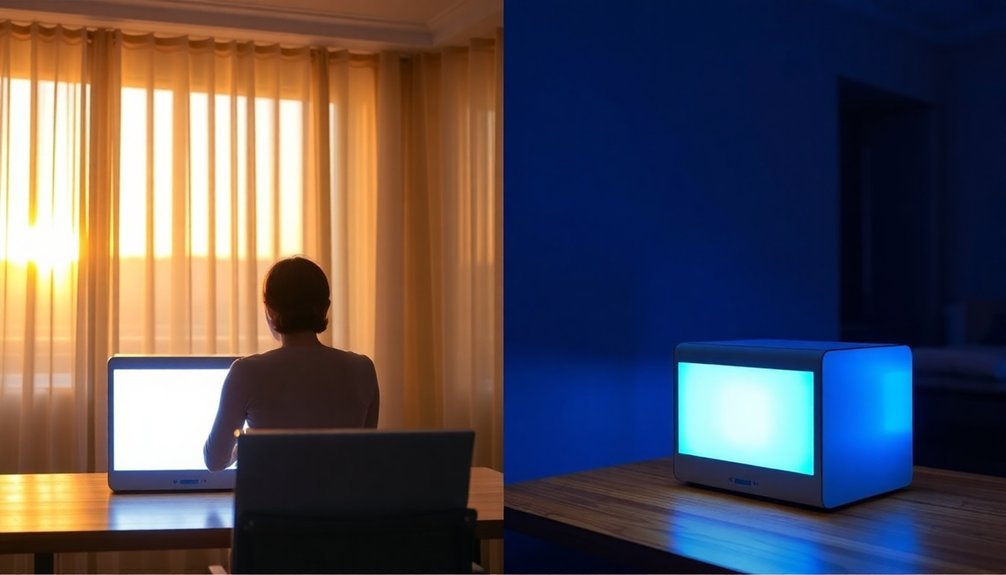
You'll find that morning light therapy proves substantially more effective than evening treatment, with remission rates of 53-62% compared to evening's 28-38%.
Your best results will come from scheduling light therapy immediately upon waking, as this timing helps advance your circadian rhythm and maximize the antidepressant effect.
For the most effective treatment, you should aim to time your light exposure about 2.5 to 3.5 hours after the midpoint of your sleep cycle, which helps synchronize the therapy with your body's natural rhythms. Research shows that treatment timed 8.5 hours after melatonin onset produces the highest success rates, achieving remission in 80% of cases.
Morning Efficacy Rates
Research consistently demonstrates that morning light therapy holds a significant advantage over evening treatments for SAD patients, with response rates reaching up to 80% in selected cases. You'll find that morning sessions produce clearer antidepressant effects and faster responses, with most patients experiencing improvements within the first week of treatment.
The success of morning light therapy depends on several key factors you'll need to take into account. You'll want to use a light box that produces at least 10,000 lux, and you should maintain consistent exposure times of 30-60 minutes each morning. Side effects are typically mild and temporary, though some users may experience headaches or eye strain. The type of light source matters too, with some LED devices proving more effective than traditional options.
Clinical studies support these findings, showing that about 70% of patients respond positively to morning light therapy. What's particularly encouraging is that these benefits aren't dependent on your age, gender, or even the time of year you begin treatment.
If you're contemplating light therapy for SAD, starting with morning sessions gives you the best chance of success, as it effectively helps regulate your circadian rhythm, which is often disrupted in SAD patients.
Optimal Treatment Timing
Building on our understanding of morning light therapy's success, the timing of treatment plays a fundamental role in managing SAD symptoms effectively. Research strongly indicates that morning sessions yield better results than evening treatments, with morning light therapy showing superior effectiveness in advancing your circadian rhythms and reducing depressive symptoms.
You'll find that the best timing for light therapy is approximately 8.5 hours after your melatonin onset. Evening light therapy, while showing some effectiveness with a 70% response rate, actually pushes your internal clock in the opposite direction of what's needed for SAD treatment.
If you're considering treatment options, it's worth noting that morning light therapy should be your first choice, as it's proven more successful in achieving remission.
While some patients report benefits from evening sessions, adding evening light to your morning treatment won't provide additional advantages. Your success with light therapy largely depends on consistency and proper timing.
If you can't maintain morning sessions, don't give up – work with your healthcare provider to find a schedule that fits your lifestyle while maximizing therapeutic benefits.
Treatment Duration and Intensity
When treating Seasonal Affective Disorder (SAD) with light therapy, proper timing and exposure levels are essential for success. You'll need to commit to daily sessions lasting 30 to 60 minutes, typically using a light box that delivers 10,000 lux.
For the best results, start your sessions early in the morning, between 6:00 a.m. and 9:00 a.m., shortly after waking up.
If you're using a light box with lower intensity, you'll need to adjust your exposure time accordingly. For instance, a 5,000-lux device requires 45-60 minutes, while a 2,500-lux unit needs 1-2 hours of exposure.
Don't be discouraged if you don't see immediate results – while some people notice improvements within days, significant benefits typically emerge after two weeks of consistent use.
Key points to remember for effective light therapy:
- Position your light box according to manufacturer guidelines for correct distance
- Don't look directly at the light; instead, keep it in your peripheral vision
- Maintain a regular sleep schedule alongside your treatment
- Continue treatments throughout the winter months
- If symptoms don't improve after two weeks, consider increasing your session time to 60 minutes
Combining Therapies for Best Results
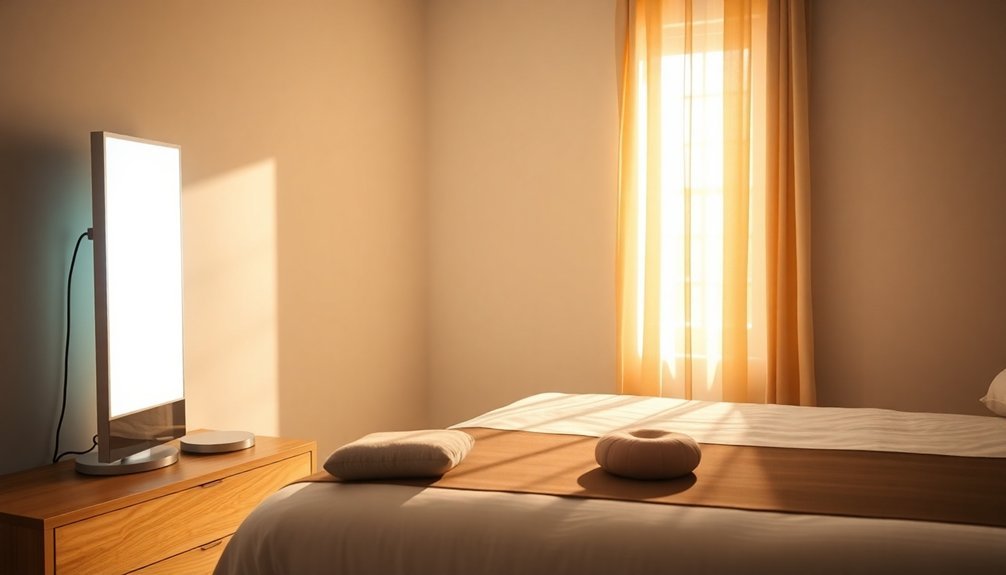
While light therapy can be effective on its own, combining it with other treatment approaches often leads to better outcomes for SAD patients. Research shows that combining light therapy with Cognitive Behavioral Therapy (CBT) can substantially improve depression symptoms, particularly in the short term.
However, you might want to reflect on the fact that CBT alone often produces better long-term results, with patients experiencing less severe symptoms and lower recurrence rates after one year.
If you're contemplating medication, you should know that about one-third of SAD patients respond better when combining antidepressants with light therapy. However, if you have bipolar disorder, you'll need careful monitoring, as light therapy can potentially trigger manic symptoms if not properly managed.
Your healthcare provider will help you choose the most suitable combination based on your specific symptoms and needs. They'll evaluate factors like the severity of your depression, any existing conditions, and your personal preferences.
While the effectiveness of combination therapies varies among individuals, you'll likely benefit from a personalized treatment approach that may include light therapy, CBT, medication, or a combination of these options.
Safety Precautions and Risks
Despite its effectiveness, light therapy comes with several potential side effects that you should understand before starting treatment. The most common issues include headaches affecting about 20% of patients, vision problems reported by 18%, and feeling "wired" experienced by 14%. While these side effects might sound concerning, they're typically mild and temporary, usually subsiding after your third day of treatment.
You'll be glad to know that most people continue their treatment successfully, as the benefits markedly outweigh the risks. To safeguard your safety during light therapy, keep these key points in mind:
- Monitor and record any side effects you experience, especially during your first five sessions
- Don't worry if you're using high-intensity light therapy – it doesn't increase your risk of side effects
- Expect most side effects to be temporary and manageable without stopping treatment
- Continue your regular daily sessions as prescribed, even if mild side effects occur
- Communicate with your healthcare provider about any persistent symptoms
While long-term research is still limited, current evidence shows that light therapy is generally safe and well-tolerated when used as directed.
Choosing the Right Device
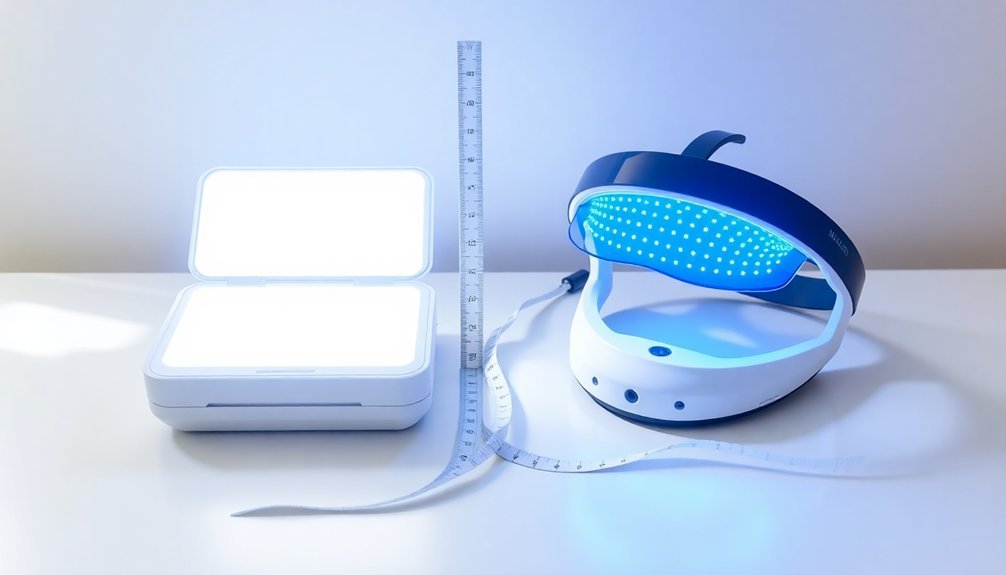
Selecting the right light therapy device can make or break your treatment success. You'll want to focus on devices that deliver 10,000 lux of full-spectrum light through a UV-filtered screen larger than 200 square inches. The most effective options are typically large light boxes that you'll use for 30 minutes each morning.
| Feature | What to Look For |
|---|---|
| Light Intensity | 10,000 lux at recommended distance |
| Screen Size | Minimum 200 sq inches |
| Safety Features | UV filter, glare reduction |
| Distance & Usage | Clear guidelines from manufacturer |
| Clinical Testing | Proven SAD treatment results |
| Light Type | Full-spectrum fluorescent |
When evaluating devices, consider well-established models like the NorthStar 10,000 or SunRay II. If you need something more compact, the BOXelite or Day-Light Sky offer reliable alternatives. You'll want to verify that your chosen device includes a broad-field illuminometer measurement and proper certification. Don't forget to check the manufacturer's distance guidelines – you'll need consistent exposure at the recommended distance to achieve the full 10,000 lux benefit. Many reputable manufacturers offer trial periods, which you should take advantage of to confirm the device meets your needs.
Insurance Coverage and Costs
Understanding the costs and insurance coverage for light therapy boxes can feel like traversing through a maze. While Medicaid typically doesn't cover light therapy boxes as standard equipment, you'll need a qualified physician to document medical necessity for potential coverage.
Private insurers like Aetna may cover high-intensity light units if you're diagnosed with bipolar disorder or recurrent major depression that meets DSM-V criteria.
When considering the cost-effectiveness of light therapy, look beyond the initial investment. Though light boxes can be expensive upfront, their amortized cost over time often makes them more economical than ongoing medication expenses.
If you're exploring alternative treatment options, online mental health services provide additional choices.
Key cost considerations to remember:
- Insurance coverage varies widely – check your specific plan's requirements
- You'll need documented medical necessity from your healthcare provider
- Initial light box costs range higher but offer long-term savings
- Online mental health consultations start at $25 through services like RedBox Rx
- Monthly medication costs begin at $25, with some services charging additional membership fees between $69-$95
Before making a decision, compare the long-term costs of different treatment options and verify your insurance coverage details.
Long Term Treatment Success
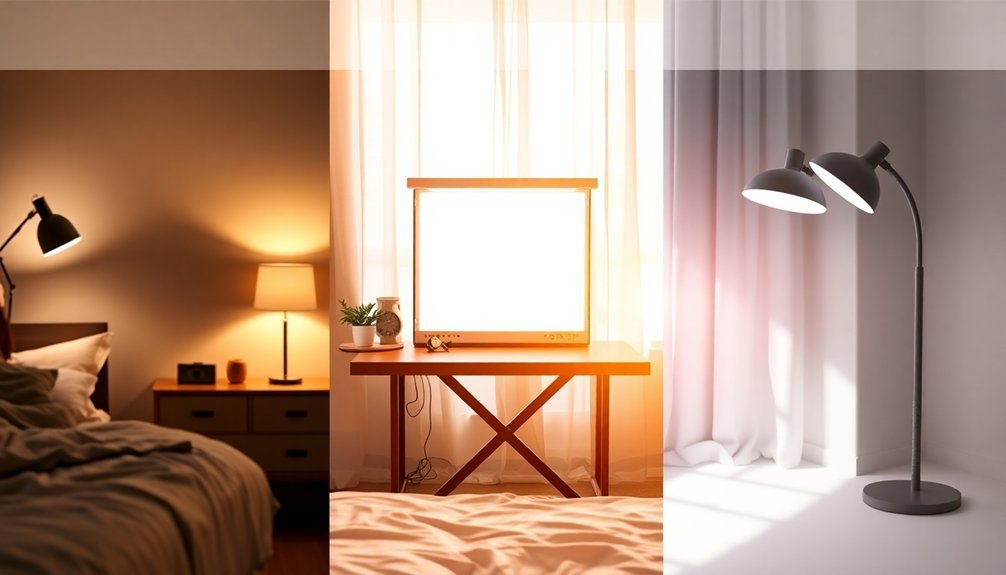
While managing costs is important, evaluating long-term success rates will help you make informed decisions about light therapy treatment.
Research shows that 60% to 80% of SAD sufferers benefit from light therapy, but you'll need to maintain daily treatments throughout the winter season to prevent relapse.
You should know that light therapy works best for short-term symptom relief but may not prevent SAD from returning next winter. Studies have found that Cognitive Behavioral Therapy specifically designed for SAD (CBT-SAD) actually produces better long-term outcomes, with lower recurrence rates of 27.3% compared to light therapy's 45.6% over two winters.
If you're considering light therapy, you'll need to use it first thing in the morning with a medically approved light box that simulates natural sunlight. Plan to spend 30 minutes to an hour each morning near your light box.
While combining CBT with light therapy might seem logical, research shows this combination doesn't improve outcomes compared to light therapy alone.
Your healthcare provider might also suggest antidepressants like bupropion XL, which has proven effective in reducing SAD episode recurrence.
Frequently Asked Questions
Can I Use Light Therapy While Taking Vitamin D Supplements?
Yes, you can safely take vitamin D supplements while using light therapy. They're complementary treatments that work differently – light therapy helps SAD symptoms directly, while vitamin D supports your overall mood and health.
Does Light Therapy Help With Jet Lag and Night Shift Work?
Yes, light therapy effectively helps you manage both jet lag and night shift work. You'll find it helps reset your circadian rhythm, improve alertness during shifts, and adjust more quickly to new time zones.
Should I Keep My Eyes Open or Closed During Treatment Sessions?
You must keep your eyes open during light therapy sessions for it to work effectively. Don't look directly at the light – instead, keep your eyes oriented toward illuminated surfaces while doing other activities.
Can Children and Teenagers Safely Use Light Therapy for SAD?
Yes, you can safely use light therapy for your child or teen with SAD. It's effective and well-tolerated, but you should consult their healthcare provider first and follow recommended guidelines for intensity and timing.
Will Using Light Therapy Affect My Ability to Sleep at Night?
If you use light therapy correctly in the morning, it won't disrupt your sleep. However, using it in the evening could make falling asleep harder. Follow recommended timing and consult a professional for best results.
In Summary
You'll find the most success with SAD light therapy by choosing a device that fits your lifestyle and following a consistent treatment schedule. Whether you opt for a desk lamp, light box, or dawn simulator, remember to consult your healthcare provider about the best timing and intensity for your needs. Combining light therapy with other treatments like exercise and counseling can maximize your results in managing seasonal depression symptoms.





Leave a Reply